St. Paul's Presbyterian Church
St. Paul's started as a community outreach project of Knox and evolved into an independent congregation. Sixty years later it amalgamated with Westminster and together they became Westminster - St. Paul's.
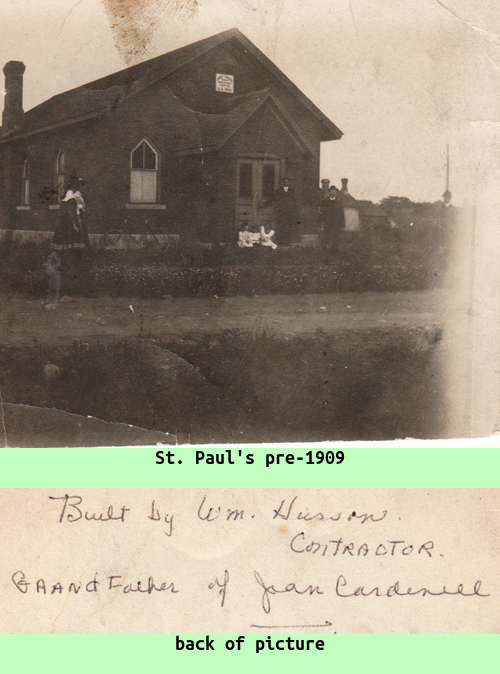
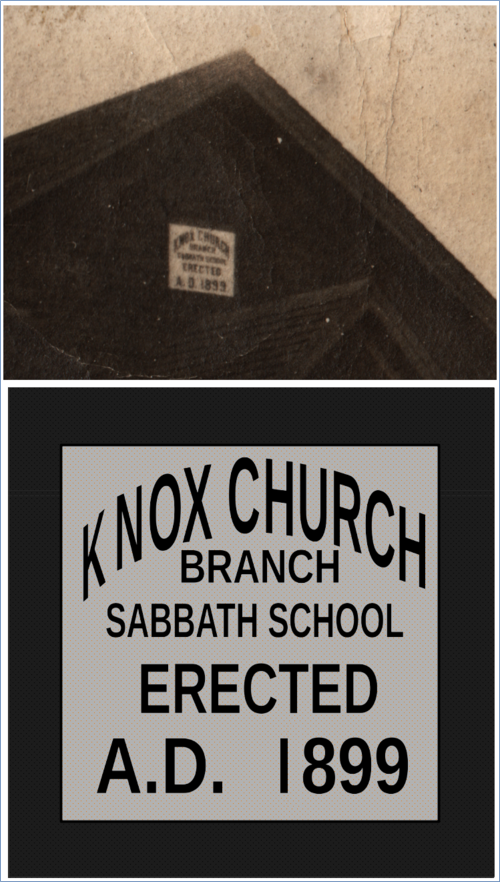
St. Paul's Sunday School
Stockdale Donaldson is identified as the superintendent. Donaldson was the husband of Mary E. Donaldson pictured with the Ladies Aid lower in this page. link The Guelph Civic Museum has a picture of Mr. Donaldson taken around 1920. link Based on that, Mr. Donaldson appears to be the taller gentleman in the back row.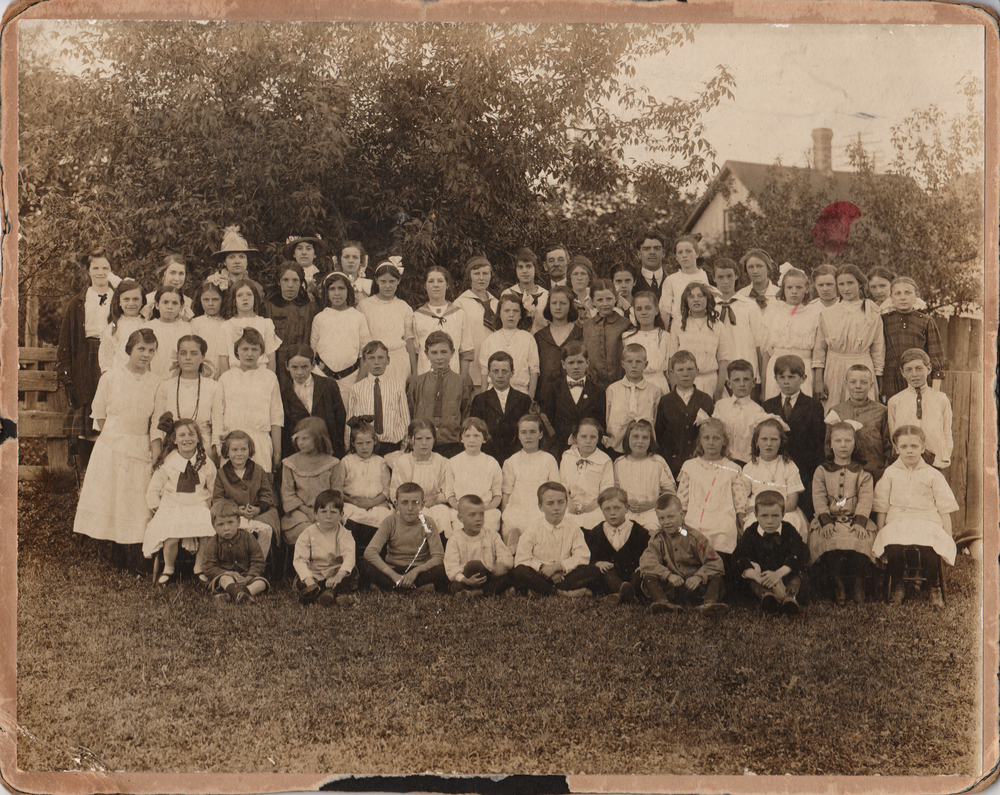

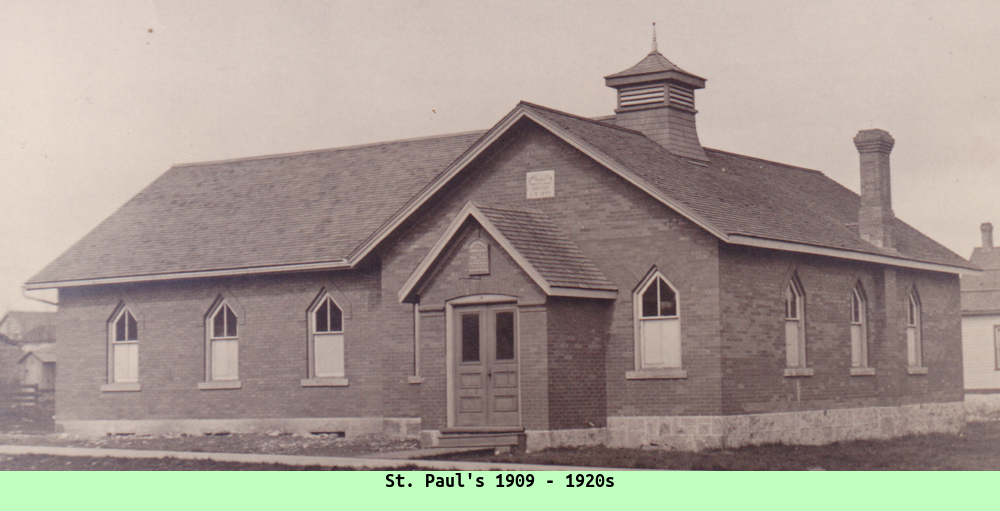
The beginning of St. Paul's
Knox History books record the following, "About the year 1889 Mrs. Thos. Goldie asked permission of the Sunday School Association to begin Sabbath School work in the St. Patrick's Ward." Permission was granted and the School Board gave them the use of a room in the School House on York Road. In 1898 the School Board reclaimed this room. It was, at this point, the Knox Sabbath School took on the task of funding the erection of a new "suitable building."The above is part of a letter from Knox Presbyterian Church (Guelph) to the Guelph Civic Museum.
Trustees of Knox, James Millar, a butcher and Andrew Scott, a Merchant signed a legal document to purchase Lot 113 on the corner of Toronto and Short Streets from Margaret and Hugh Henry, a Plasterer by trade. Once established in their own building they decided to hold Church services each Thursday evening. Eventually, "This school led to the formation of a separate congregation known as St. Paul's Presbyterian Church."
The following historical sketch was published in the First Twenty-Five.
It has been converted to text format to improve its legibility. As well it can now be copied and searched (for the benefit of future historians).
It has been converted to text format to improve its legibility. As well it can now be copied and searched (for the benefit of future historians).
HISTORICAL SKETCH
The beginnings of this Congregation go back to the 8th of February 1889. In that year the Sunday School Association of Knox Church passed a resolution "to take steps to organize a Mission School in St. Patrick's ward and application be made to the School Board for the use of the School". Hence, later that month a Sunday School of 30 pupils commenced in Tytler School to take care of the Christian Education of the children in that part of the city. The following year, deprived of the use of the school, they decided to erect a building and in the meantime the Sunday School continued in homes, and a regular prayer meeting began. The building was shortly completed and the work continued down through the years. The year 1909 saw it necessary to add to the building and the first evening service of worship was conducted. Two years later the work at St. Paul's, which was now its name, had advanced to the stage when it was formed into a Congregation by the Presbytery of Guelph and its charter membership roll of November 13, 1913, shows 39 names. The same year there came as its first minister Rev. C.F. McIntosh, who was ordained and inducted into St. Paul's on 22 December. The first Communion service saw 131 partaking of the Sacrament. The morning service was then instituted and Mr. George Olde became its first "Choir Teacher" and Miss M. Husson, the first organist, when a new organ was given to the Church by the Choir. By this time a membership of 171 was active in the work of the Congregation.A number of ministers served the Congregation following the resignation of Rev. C.F. McIntosh in 1917. Rev. K.H. Palmer 1917-1918; Rev. G.C. Little 1919-1925. During the Ministry of Rev. G.C. Little the Church was remodelled, widened and the roof was raised and the question of Church Union came to the fore. The latter was decided when the Congregation voted 90-25 to remain in the Presbyterian Church in Canada. The Rev. George Atkinson who next came to lead the Congregation remained for seven years and then in 1932 the Congregation was in financial straits with many others as adverse times befell the country.
Students from Knox college supplied the services for a number of years and finally St. Pauls was joined with Eden Mills and Rockwood into one pastoral charge. Rev. Samuel Johnston, one of students, became the minister of the Congregation when he graduated and laboured there from 1937-1939 until he resigned to go to Peterborough. He was followed by Rev. A.H. Wilson and then by Dr. W.J. McIvor who ministered to the congregations of St. Pauls, Eden Mills and Rockwood until 1946 when he returned to Ireland. Rev. Fred Williamson supplied for a time during Dr. McIvor's leave of absence in Ireland and he became their Minister in 1947 where he remained until he retired in June 1959, thus having the longest pastorate in the history of the Congregation. In 1954, St. Pauls separated from Eden Mills and Rockwood and became a Congregation on its own, but in a changing district and with its people moving to other parts of the growing city, the Congregation found it difficult to operate. After long consideration it was decided to amalgamate with Westminster Church in a new section the city and this was approved by the Presbytery of Guelph in 1959.
It is difficult to assess the impact of St. Paul's on that portion of the city in which it was situated. Down through the years its services have brought comfort, strength, and the power of Christ to its worshippers. It has been a continuing service of instruction in the things of the Gospel to children through its Sunday School for 70 years. The various organizations of faithful men and women have given their time, talents and abilities to the Kingdom of God. Through sucess and adversity, prosperity and depression, war and peace, Ministers, elders and people served their Lord and Master faithfully and well. It is, however, not the end, but a new beginning, as St. Paul's, its history, its traditions, its memories and labours join with Westminster, that as Westminster-St. Paul's, the Gospel of Christ may be presented to a growing community in another part of the city.
John Milton
It is difficult to assess the impact of St. Paul's on that portion of the city in which it was situated. Down through the years its services have brought comfort, strength, and the power of Christ to its worshippers. It has been a continuing service of instruction in the things of the Gospel to children through its Sunday School for 70 years. The various organizations of faithful men and women have given their time, talents and abilities to the Kingdom of God. Through sucess and adversity, prosperity and depression, war and peace, Ministers, elders and people served their Lord and Master faithfully and well. It is, however, not the end, but a new beginning, as St. Paul's, its history, its traditions, its memories and labours join with Westminster, that as Westminster-St. Paul's, the Gospel of Christ may be presented to a growing community in another part of the city.
John Milton
When the St. Paul's congregation amalgamated with Westminster their Church building was turned over to Westminster St. Paul's. In 1960 it was sold to Life & Glory Temple for the sum of $7,500.00. Below left is a 1960 picture of St. Paul's Church. It was kindly provided to us by the Guelph Civic Museum and is page 61 of item 2015_64_1 in their collection.

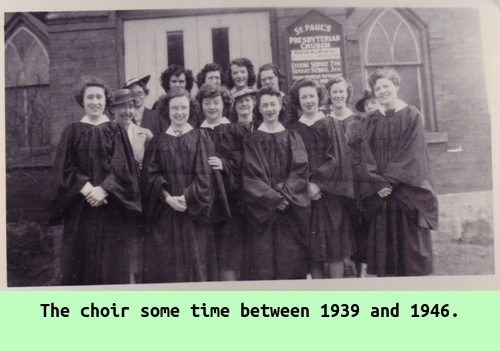
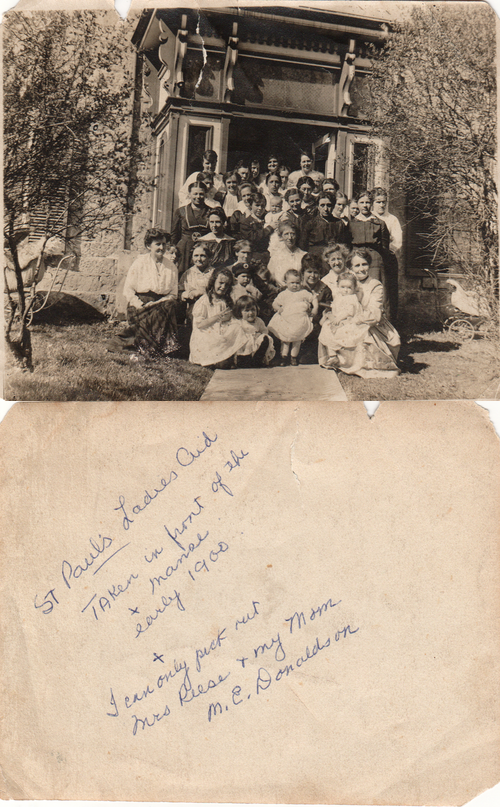
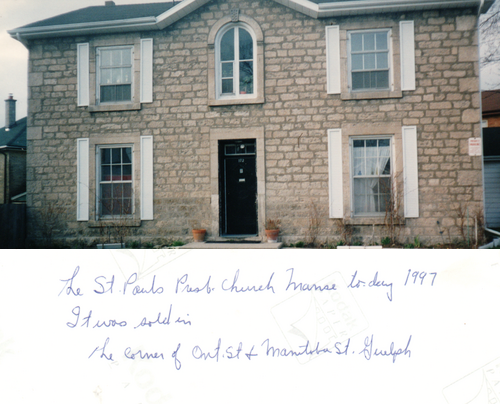
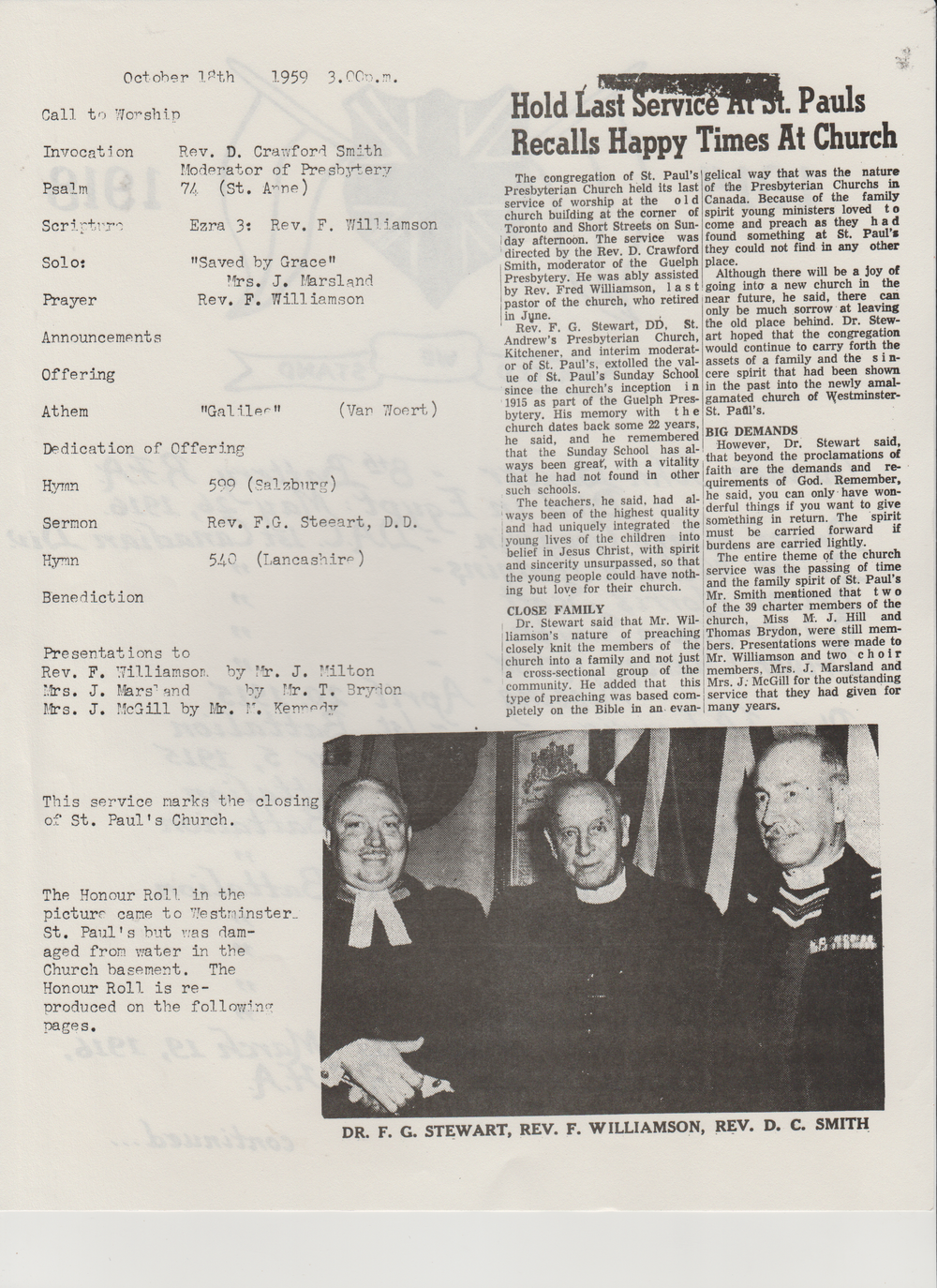
The Honour Roll
The Honour Roll below is as found in the history cabinets rather than the black and white version found in The First Twenty-five.
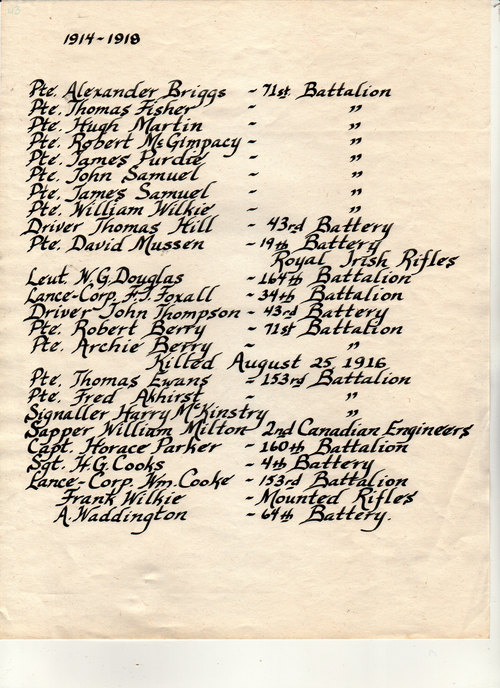
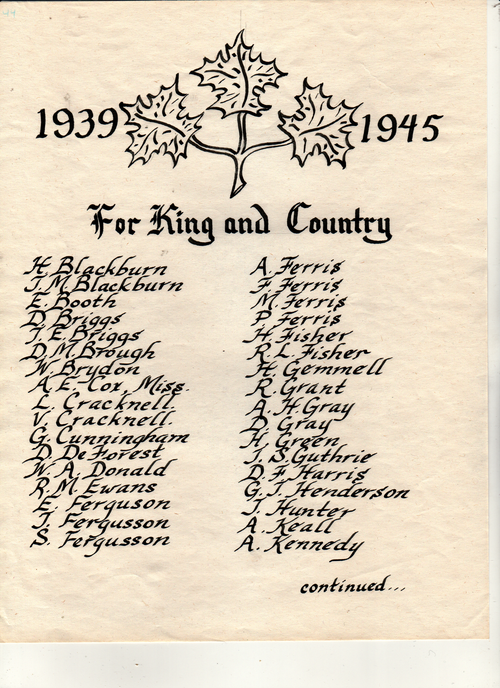
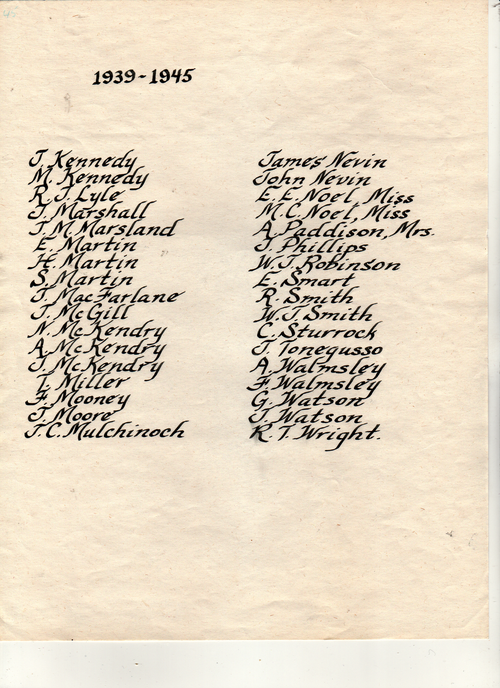
Another historical sketch
Westminster-St. Paul's Church
Westminster-St. Paul's, as we know it today, came from the joining together of two churches: Westminster and St. Paul's.
St. Paul's
In February 1889, a Sunday School of 30 pupils commenced in Tytler School to take care of the Christian Education of the children in St. Patrick's Ward of Guelph.
In 1890, deprived of the use of the school, it was decided to erect a church building, while Sunday School continued in homes and a regular prayer meeting was held.
In 1909, an addition was made to the church and two years later, the congregation of St. Paul's was formed by the Presbytery of Guelph. Its Charter Membership Roll of November 13, 1913 showed 39 names.
The women's groups have always played an important role in our church.
St. Paul's Ladies Aid was formed more than 60 years ago. This group was always very active in the church, raising money through teas, dinners, rummage sales and bazaars held in the basement of the church.
During the 1930's, St. Paul's could not afford a full-time custodian and the Ladies thought nothing of coming early to church, on the day of an activity to chop kindling to start a fire in the furnace.
When funds were low, an anonymous donor would keep the coal bin filled, so that the church was warm for Sunday services.
When the church needed painting, the men of the congregation would band together to perform this task.
The church was the centre of the community and there was a closeness among the congregation that was very heart-warming. Many fun times were enjoyed in the basement of the church and friendships formed that have lasted to the present day.
The St. Paul's Ladies Aid became the Goodwill Circle of Westminster-St. Paul's.
During the 1930's, St. Paul's could not afford a full-time custodian and the Ladies thought nothing of coming early to church, on the day of an activity to chop kindling to start a fire in the furnace.
When funds were low, an anonymous donor would keep the coal bin filled, so that the church was warm for Sunday services.
When the church needed painting, the men of the congregation would band together to perform this task.
The church was the centre of the community and there was a closeness among the congregation that was very heart-warming. Many fun times were enjoyed in the basement of the church and friendships formed that have lasted to the present day.
The St. Paul's Ladies Aid became the Goodwill Circle of Westminster-St. Paul's.
The above appears to have been written some time around 1960.
The historical sketch below was found in the history cabinets. It is archived as item 259 and consists of three typed pages. It was used in the bulletin for the last service at St. Paul's.
As with the other two sketches and the letter exerpt, it has been converted to text format.
As with the other two sketches and the letter exerpt, it has been converted to text format.
A BRIEF HISTORICAL SKETCH OF ST. PAUL'S CHURCH
The beginnings of this congregation go back to the 8th of February, 1889. On that date, the Sunday School Association of Knox Church passed a resolution "to take steps to organize a branch in St. Patrick's Ward and application be made to the Public School Board for the use of their school in that district".
Later that month, permission having been granted by the Board of Education, the Branch Sunday Schocol was established. Mrs. Thos. Goldie was the first Superintendant and she commenced the work with 30 pupils. Shortly efterwards Mrs. Goldie retired and a Mr. Robt. Johnston was appointed in her stead. For fourteen years he and Mrs. Wm. Scrimigeour were the chief workers.
In 1899 the school was deprived of the use of the room in the public school, and, as the work had prospered abundantly it was decided to erect a building on the corner of Toronto and Short streets. For five months before the completion of this building the school met in the home of Wm. Scrimigeour, Neeve St.
In May 1909, it was found necessary to enlarge the building and regular prayer meetings began. Then on November 5th, 1911, the first of regular evening services was started (in what was now Knox Branch Church) by Mr. W. Ross, a student of Knox College who on that day took up the work as assistent in Knox Church with special oversight of the Branch. This arrangement was continued until the forming of St. Paul's.
On November 13, 1913 at a meeting attended by a large number of persons, who for some time past had been attending the Sunday evening services, the Congregation of St. Paul's was established. That same year the Rev. C. F. McIntosh, the first minister, was ordained and inducted of the 22nd of December. The first Communion service saw 131 partaking of the Sacrament. The morning service was then instituted and Miss M. Husson, the first organist, presented a new organ to the Church from the choir. By this time a membership of 171 was active in the work of the Congregation.
A number of ministers served the Congregation following the resignation of Rev. McIntosh in early 1917. Rev. K. H. Palmer (an eloquent speaker and shrewd business man) undertook the work until his resignation in late 1918 to take over and operate a large family business in the north.
He was followed in 1919 by Rev. G. C. Little. During the ministry of Mr. Little the Church was remodelled, widened and a new roof was raised, all this at considerable cost. While this work was underway the services were held in a large tent on the adjoining lot. Then the question of Church Union came to the fore. The matter was decided when the Congregation voted 90 to 25 to remain in the Presbyterian Church. This was a very serious reverse to St. Paul's as the 25 mentioned all went to the various United Churches. They had all been good, dedicated workers and supporters of the Church. This left our weakened Congregation with a heavy burden of debt and a terrible depression only five years away.
The Rev. Geo. Atkinson who next came to lead the Congregation remained for seven years and then in 1932 the Congregation was in dire financial straits, along with many others, as adverse times were rampant in the country. Indeed at one period in the depression only three men in the Congregation were drawing a full week's pay.
Upon the resignation of Mr. Atkinson, the manse, which was purchesed during the ministry of Mr. Palmer, was sold and application made to Presbytery to link St. Paul's to the Rockwood and Eden Mills Congregations. These three Congregations appointed a joint committee for matters of mutual concern and Services were conducted by students from Knox College for several years. They would come up for the week-end services and during the summer stay on the field full time.
Rev. Samuel Johnston, one of these students, became the Minister when he graduated in 1937 and resigned to accept a call to Peterborough in 1939. He was followed by Rev. A. H. Wilson until the spring of 1941 and then by Rev. Dr. W. J. McIvor, a very talented and able preacher. Dr. McIvor had wanted to give up the burden of a large, fashionable Church in Montreal to take on lighter, less arduous and demanding work. He came in the summer of 1941 and stayed until 1946 when he returned to his old home in Ireland. It must have been a tremendous change for the good Doctor to give up an extremely wealthy congregation and come to a charge of three small Churches. However, he seemed to enjoy it and was very happy and contented in Guelph.
In 1946 Rev. Fred Williamson, who had supplied at St. Andrew's, Kitchener, during the war absence of Dr. Finley Stewart, took up the work. A grand, warm-hearted, down-to-earth man who many of you will remember having heard preach in this Church.
In 1954 St. Paul's separated from Rockwood and Eden Mills and again became a Congregation on its own. In March of 1959, Mr. Williamson, after a sudden and severe illness, informally called the Elders together and informed them that due to advancing years and failing health he wished to retire and was therefore submitting his resignation to Presbytery, this to take effect at the end of June. The Elders and Congregetion regretfully prepared themselves for the termination of an association with one whose warm personality had endeared him to all.
It now became necessary to make a good hard analysis of our position. We were in a changing district. The surrounding area was rapidly becoming populated by people of other denominations. Some of our people were moving to other parts of the growing city. Death had taken some of our older members and some of the younger had left town. The expansion of Guelph was in sections a considerable distance away so that any potential was practically nil, and now we were without a Minister.
It would be much too difficult and definitely useless to continue to operate. We were faced with dissolution of the Congregation, but our people loved the old Church, its memories and its traditions and this was, in spite of the untenable situation, a heart-wrenching decision to make. We then invited in Dr. Finlay Stewart who was a good friend of our Congregation for 22 years. He was always interested in and fully aware of our problems. There was a lengthy discussion which culminated in a decision to amalgamate St. Paul's with Westminster. This amalgamation to take place as soon as expedient, retaining the identity of the name, St. Paul's. The petition was duly agreed to by the Westminster Congregetion and subsequently granted by Presbytery to take effect on October 25th with the last service in St. Paul's on October 18th, 1959 and the amalgamated Congregation to be known as Westminster-St. Paul's.
Two of the charter members of the old Church are still members here but now, because of infirmities, unable to attend. Their names - Miss M. J. Hill and Mr. T. Brydon, a long-time Elder.
The Ladies Aid was always very active and a strong right arm, particularly during the depression and other times of great need. One of our members, Mrs. Jordan, has continually been a faithful worker for 48 years and has also been treasurer of our group since 1940.
The Sunday School had always great vitality. The teachers had been of the highest quality and had with unsurpassed sincerity integrated the young lives of the children into spiritual values so thet the young people could have nothing but love for the Church. Two of these teachers were Mrs. John Smith and Miss M. J. Hill, both of whom served for more than twenty-six years.
The nature of St. Paul's was always such that its members resembled a closely knit family rather than just a cross-section of the community. Because of this family spirit, young students loved to come back and preach because they found something warm and satisfying.
It may be of interest here to note two remarkable coincidences with our ministers and students. Rod. Berliss, a student who had been with us for well over a year, later on became Minister of the Montreal Church which Dr. McIvor had vacated to come to St. Paul's. Student Grant McDonald, a frequent supply, later became assistant to Dr. Stewart in St. Andrew's at which Mr. Williamson had supplied during the war.
It, is difficult to assess the true impact of St. Paul's but it was considerable. Down through the years its services brought comfort and strength to its worshippers. It provided brotherhood and good fellowship. It had been a continuing service of instruction in the things of the Gospel to children through the Sunday School for 70 years. The various organizations of faithful men and women gave freely of their time, talents and abilities to the Church. Through success and adversity, prosperity and depression, war and peace, Ministers, Elders, Office Holders and steadfast members served their Lord and Master faithfully and well.
In conclusion - Most of these writings were copied directly from record books etc. with deletions made for the sake of brevity. Some of these matters came to the knowledge of the writer in conversations over the years and some are personal observations and comments. There was a strong temptation to go further into details about people, happenings and events which would, perhaps, have been of interest, but again brevity was the keynote.
It has been a pleasant duty to delve into the records of the past and compile these writings. It is hoped that they may bring a spark of pleasure in the recounting.
In 1954 St. Paul's separated from Rockwood and Eden Mills and again became a Congregation on its own. In March of 1959, Mr. Williamson, after a sudden and severe illness, informally called the Elders together and informed them that due to advancing years and failing health he wished to retire and was therefore submitting his resignation to Presbytery, this to take effect at the end of June. The Elders and Congregetion regretfully prepared themselves for the termination of an association with one whose warm personality had endeared him to all.
It now became necessary to make a good hard analysis of our position. We were in a changing district. The surrounding area was rapidly becoming populated by people of other denominations. Some of our people were moving to other parts of the growing city. Death had taken some of our older members and some of the younger had left town. The expansion of Guelph was in sections a considerable distance away so that any potential was practically nil, and now we were without a Minister.
It would be much too difficult and definitely useless to continue to operate. We were faced with dissolution of the Congregation, but our people loved the old Church, its memories and its traditions and this was, in spite of the untenable situation, a heart-wrenching decision to make. We then invited in Dr. Finlay Stewart who was a good friend of our Congregation for 22 years. He was always interested in and fully aware of our problems. There was a lengthy discussion which culminated in a decision to amalgamate St. Paul's with Westminster. This amalgamation to take place as soon as expedient, retaining the identity of the name, St. Paul's. The petition was duly agreed to by the Westminster Congregetion and subsequently granted by Presbytery to take effect on October 25th with the last service in St. Paul's on October 18th, 1959 and the amalgamated Congregation to be known as Westminster-St. Paul's.
Two of the charter members of the old Church are still members here but now, because of infirmities, unable to attend. Their names - Miss M. J. Hill and Mr. T. Brydon, a long-time Elder.
The Ladies Aid was always very active and a strong right arm, particularly during the depression and other times of great need. One of our members, Mrs. Jordan, has continually been a faithful worker for 48 years and has also been treasurer of our group since 1940.
The Sunday School had always great vitality. The teachers had been of the highest quality and had with unsurpassed sincerity integrated the young lives of the children into spiritual values so thet the young people could have nothing but love for the Church. Two of these teachers were Mrs. John Smith and Miss M. J. Hill, both of whom served for more than twenty-six years.
The nature of St. Paul's was always such that its members resembled a closely knit family rather than just a cross-section of the community. Because of this family spirit, young students loved to come back and preach because they found something warm and satisfying.
It may be of interest here to note two remarkable coincidences with our ministers and students. Rod. Berliss, a student who had been with us for well over a year, later on became Minister of the Montreal Church which Dr. McIvor had vacated to come to St. Paul's. Student Grant McDonald, a frequent supply, later became assistant to Dr. Stewart in St. Andrew's at which Mr. Williamson had supplied during the war.
It, is difficult to assess the true impact of St. Paul's but it was considerable. Down through the years its services brought comfort and strength to its worshippers. It provided brotherhood and good fellowship. It had been a continuing service of instruction in the things of the Gospel to children through the Sunday School for 70 years. The various organizations of faithful men and women gave freely of their time, talents and abilities to the Church. Through success and adversity, prosperity and depression, war and peace, Ministers, Elders, Office Holders and steadfast members served their Lord and Master faithfully and well.
In conclusion - Most of these writings were copied directly from record books etc. with deletions made for the sake of brevity. Some of these matters came to the knowledge of the writer in conversations over the years and some are personal observations and comments. There was a strong temptation to go further into details about people, happenings and events which would, perhaps, have been of interest, but again brevity was the keynote.
It has been a pleasant duty to delve into the records of the past and compile these writings. It is hoped that they may bring a spark of pleasure in the recounting.
The last service
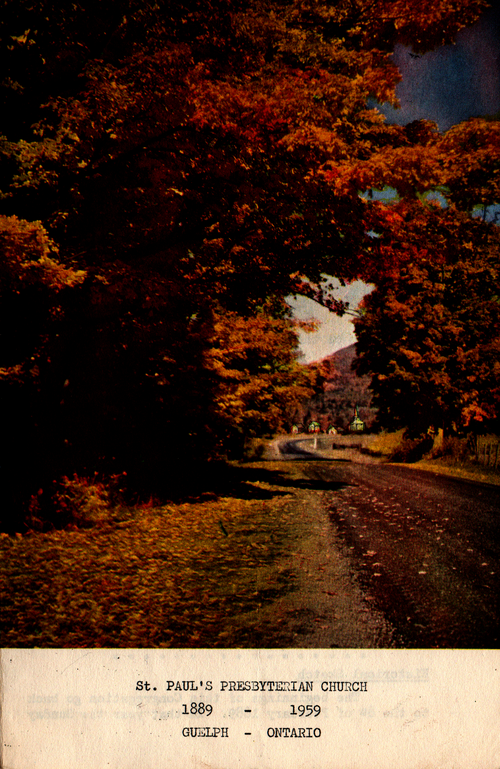
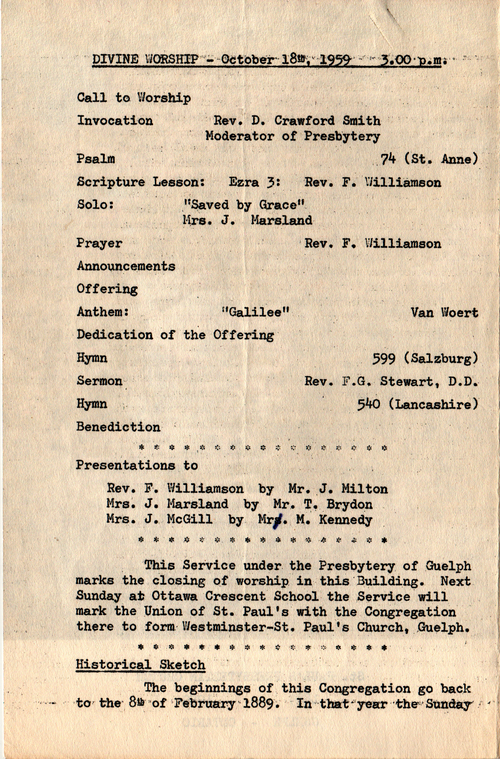
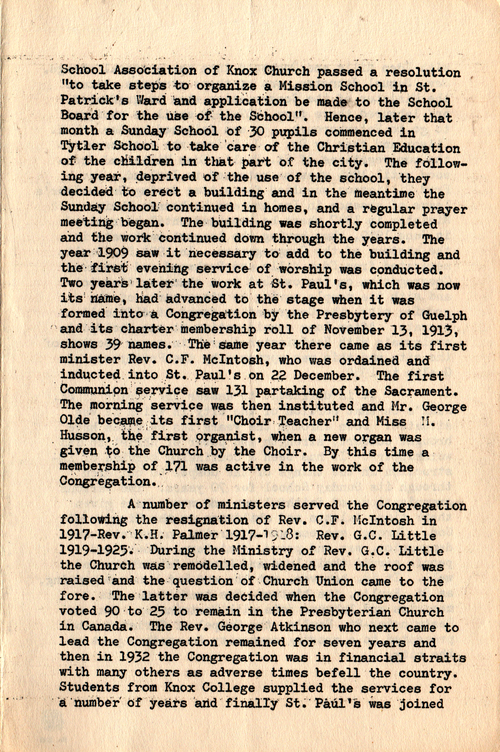
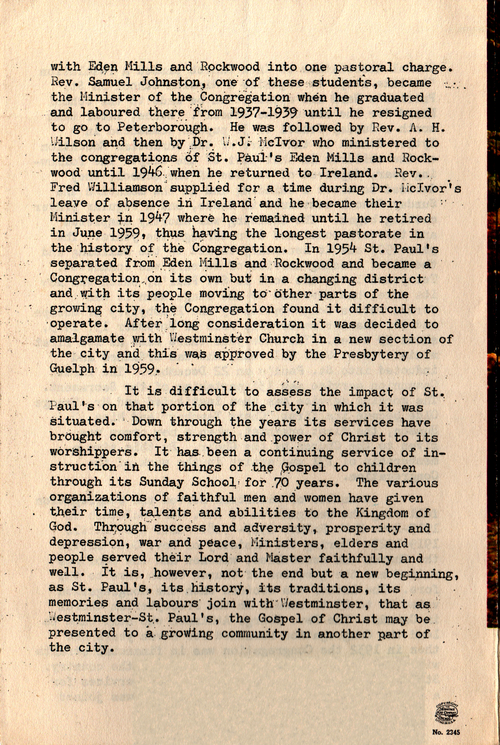
The following two images were provided by Donna Speers, archivist of Knox Presbyterian Church (Guelph).
Also of interest is the 1910 St. Paul's Signature Quilt. link
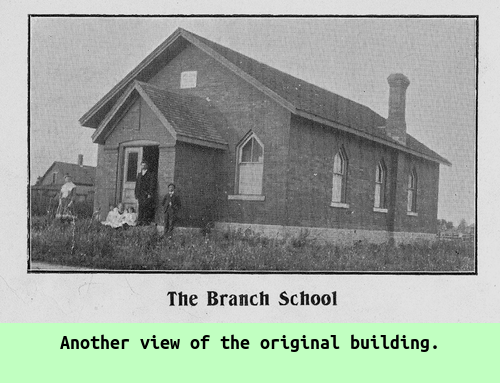
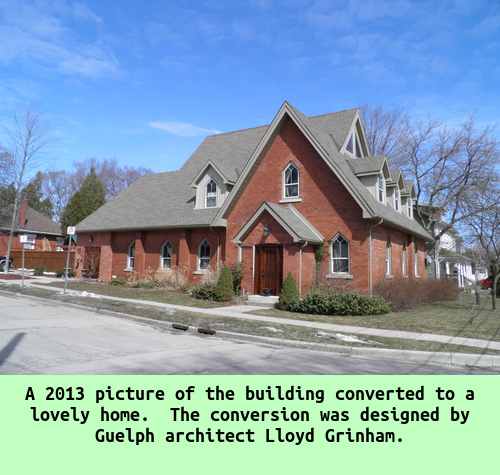
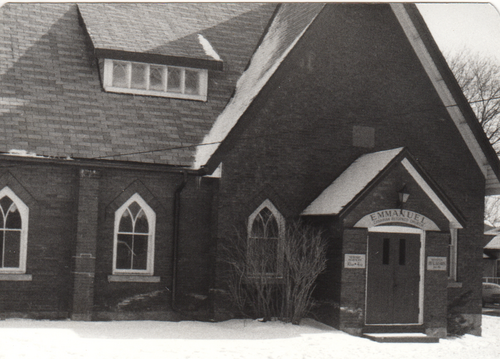 | The image on the left is of the church building when it was occupied by Emmanuel Canadian Reform church some time between the 1970s and 2002. |
Rev. Fred Williamson
Rev. Williamson was the last minister at St. Paul's and maintained a warm relationship with the congregation after it moved to Westminster - St. Paul's.
The picture below is from The First Twenty-Five. The newspaper clippings and bio are part of item 358 in the archive.
The picture below is from The First Twenty-Five. The newspaper clippings and bio are part of item 358 in the archive.
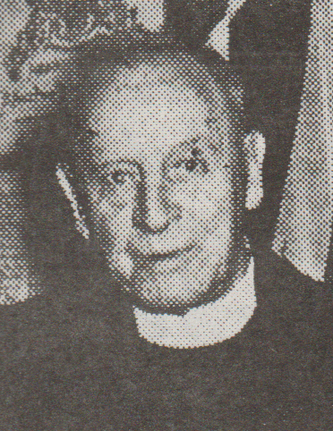
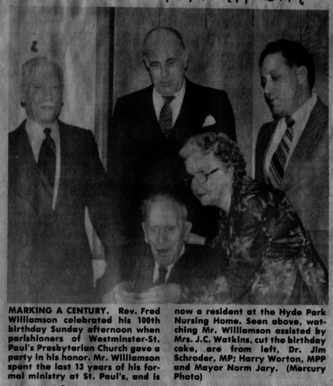
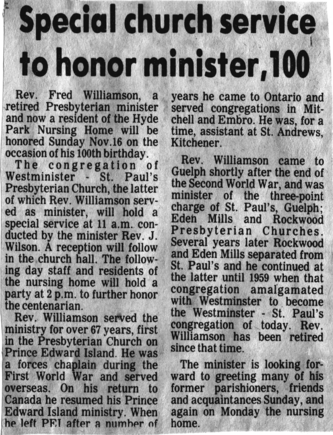
Rev. Fred Williamson, who today celebrates his 100th birthday, was born: in 1880 in Lisburn; near Belfast, Ireland.. When he first left school, he went into the bleaching and dyeing business in Belfast. As a young man of 23, he heard the Call of God to preach the gospel, and began his theological studies, mainly at Glasgow University. During. his years as a student minister he preached all over Scotland.
He came to Canada in 1910, and landed on a mission field in rural Alberta, travelling by horse and cutter, often in -40° weather. He later studied at Trinity: college in Toronto. Upon graduation he volunteered for service with the 95th Battalion of Toronto, and was stationed during the 1st World War at Ypres.
Following the war he ministered in Nova Scotia, P.E:I., and Ontario.
He came to Canada in 1910, and landed on a mission field in rural Alberta, travelling by horse and cutter, often in -40° weather. He later studied at Trinity: college in Toronto. Upon graduation he volunteered for service with the 95th Battalion of Toronto, and was stationed during the 1st World War at Ypres.
Following the war he ministered in Nova Scotia, P.E:I., and Ontario.
He spent a year in St. Andrew's Church, Kitchener, and then moved to Guelph, to St. Paul's Presbyterian Church, where he spent the last 13 years of his formal ministry. Upon his "retirement", he continued to serve his Lord in the parishes of Campbeliville, Nassagaweya, Rockwood, and Westminster-St. Paul's.
His later years have been spent at the Hyde Park Nursing Home, where his friends from "old St. Paul's" are able to visit him and reminisce.
We are pleased and honoured to join Mr. Williamson in celebrating this very, special occasion.
The above bio was typed on a 5"x7" piece of paper. Hand written on the bottom was the information that: Rev. Williamson died July 13/1981
In an oral communication Gladys Robson stated that he is buried in Eden Mills.
His later years have been spent at the Hyde Park Nursing Home, where his friends from "old St. Paul's" are able to visit him and reminisce.
We are pleased and honoured to join Mr. Williamson in celebrating this very, special occasion.
The above bio was typed on a 5"x7" piece of paper. Hand written on the bottom was the information that: Rev. Williamson died July 13/1981
In an oral communication Gladys Robson stated that he is buried in Eden Mills.